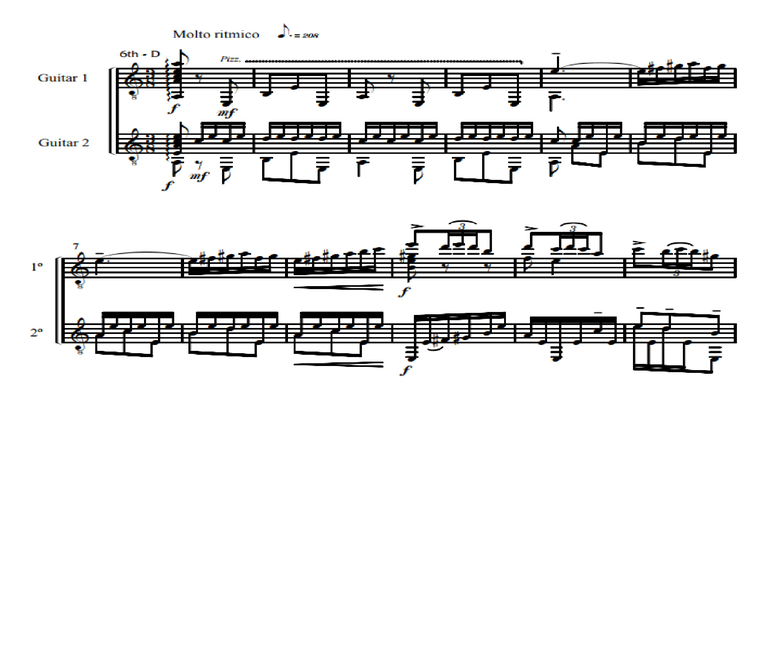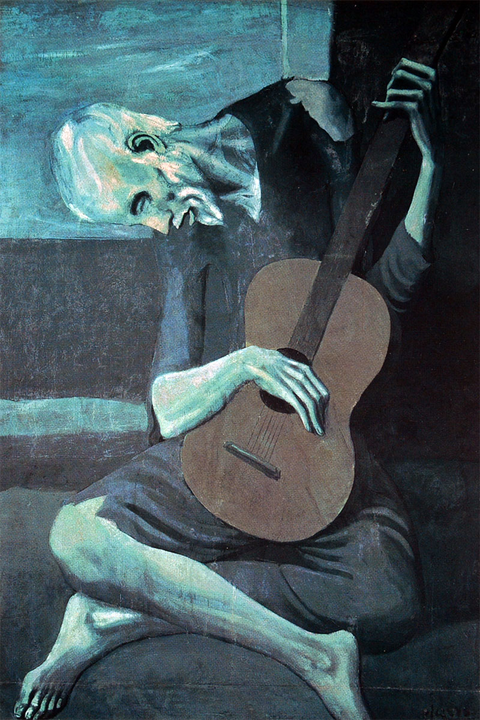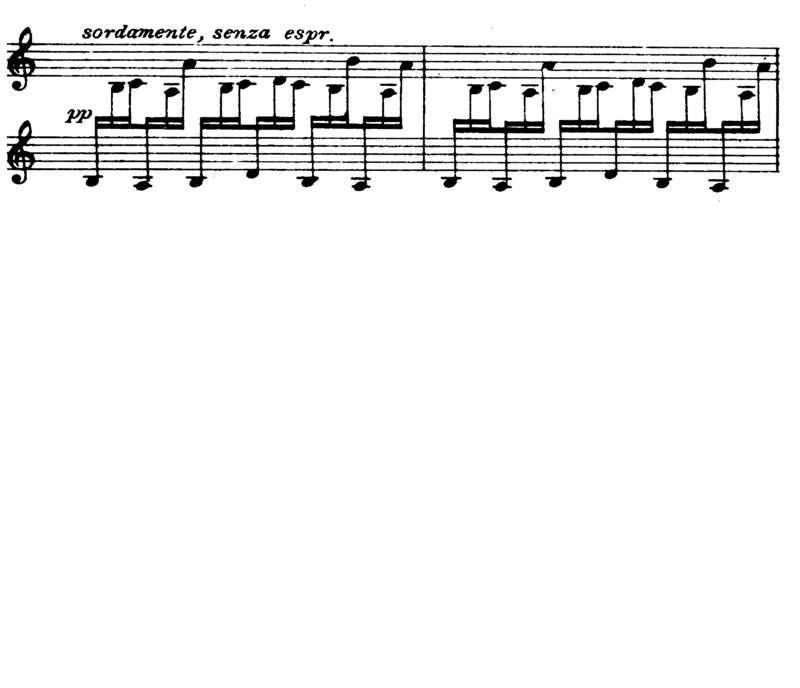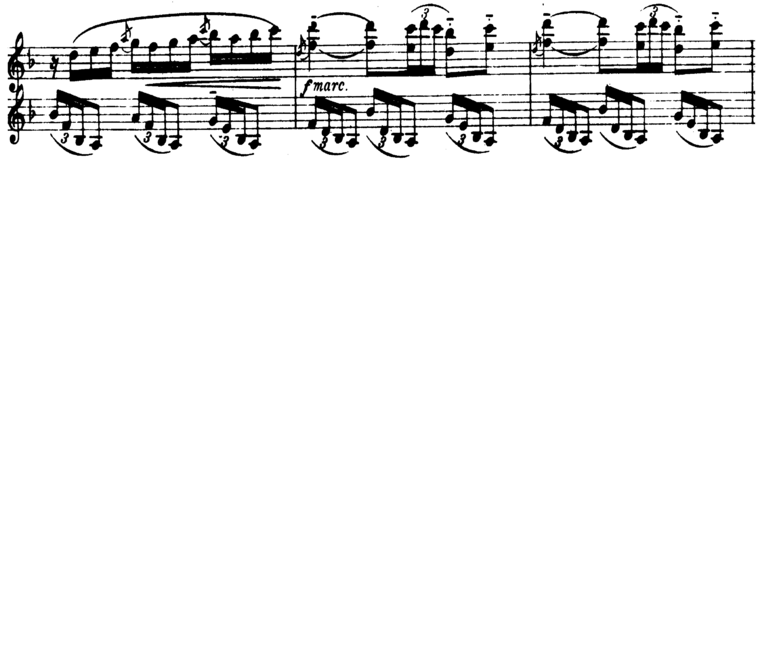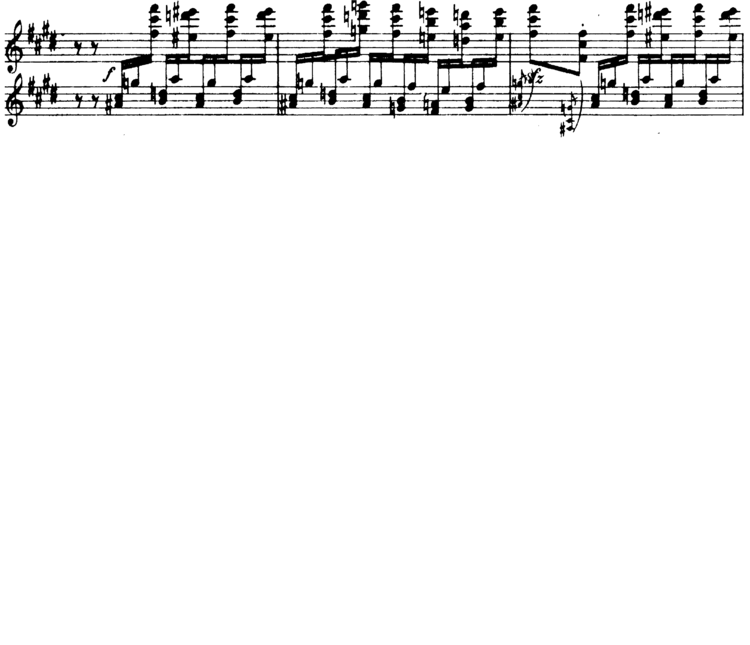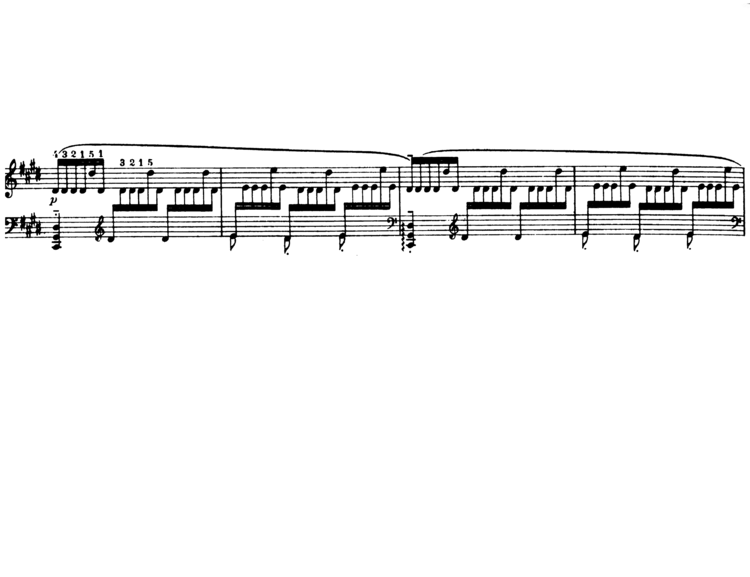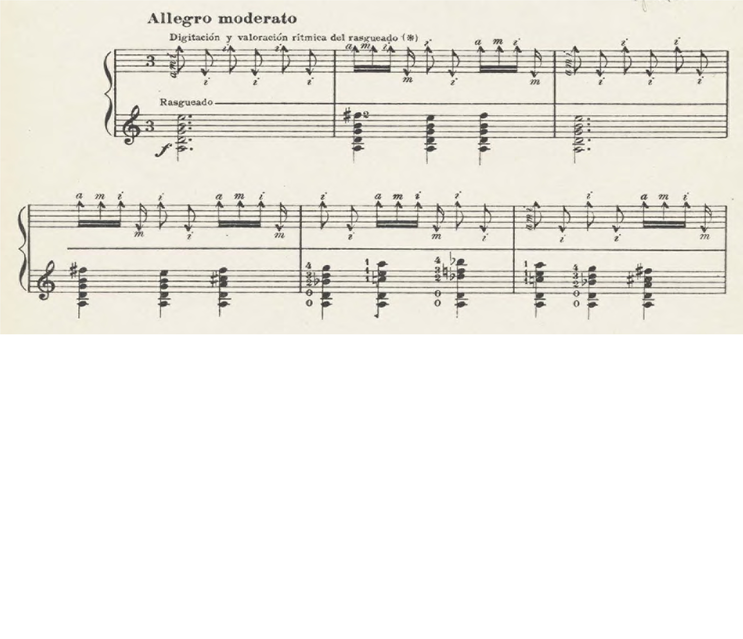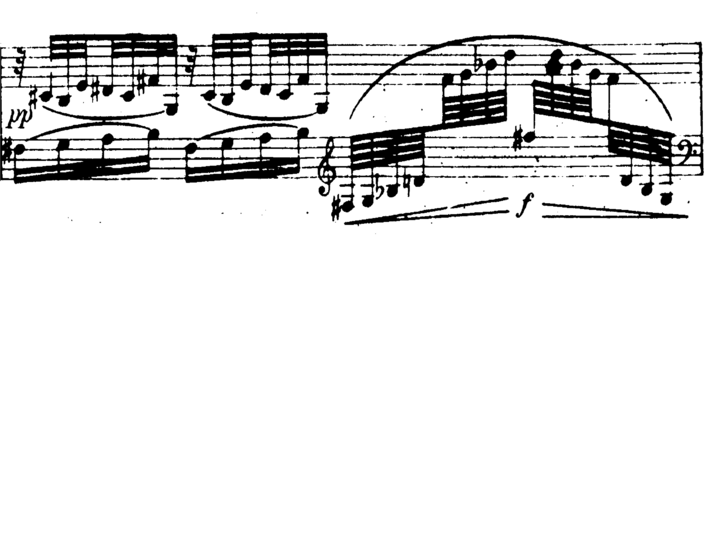The influence from Debussy´s writing will be studied in the chapter "Debussy´s Spanish music".
In order to reach an appropriate interpretation of Falla´s music it is important to understand his thoughts about the individual “values” of guitar. Therefore, the difference between Moorish and Spanish guitar should be known. In one of his essays Manuel de Falla writes:
Here, another remarkable guitar attack may be understood. Score example 7 presents a guitar arrange of Danza Española from Falla´s La Vida Breve (1913). Two guitar version has been chosen in pro of a better understanding. In bars 10 and 11, the piece presents two triplets with a slur. As it may be seen in video example 4, triplets are performed with just one attack at the beginning of the first note of each group. This approach causes an accent followed by a big diminuendo.
A very similar turnaround could be found in the first piano solo of the second movement of Nights in the Spanish Gardens (score example 8). Furthermore, the triplets should be performed with the same considerations mentioned before. Audio example 4 shows an example of this particular sound.
Another aspect to consider is the apearance of different arpeggios in the left hand. The previously mentioned “rasgueado” technique is again present in this passage, therefore, a similar approach is highly recommended.
3. Manuel de Falla and the spanish guitar
First of all it is worth considering that the Spanish guitar is one of the most important instruments in the Andalusian culture. Guitar has not only been used as an accompaniment instrument, but also as a soloist. Because of it, during hundreds of years, guitarists have developed an enormous number of ways of playing the instrument.
Manuel de Falla, who was truly interested on the Spanish culture, had a huge knowledge of the real way of playing guitar in Andalucía.
From 1907, He maintained a good relationship with Angel Barrios (1882-1964), one of the best Spanish guitarists of that time. Falla listened to him in several private concerts and annotated the particularities of his playing. The influence of Angel Barrios during Falla´s years in Paris is evident in his music.
After many years of study, Falla was a reference of the real way of playing Spanish guitar. The above is proved when Falla is asked by Emilio Pujol to write the prologue of his book Escuela Razonada de la Guitarra. In the prologue, Falla shows a profound love and knowledge of the instrument as well as the andalusian music.
Falla wrote in some articles his thoughts about the role of guitar and his correct playing. Is, again, in Claude Debussy´s music where Falla finds the real translation from guitar to piano.
3.1. The Spanish guitar in Nights in the Spanish Gardens
The following examples are based on Manuel de Falla´s personal thoughts about the Spanish guitar. The sonority of them is always in relationship with a concrete guitar touch or attack. Therefore, the performance in the piano will aim to that sonority.
The values refereed above will be taken into account (rhythm and harmony), however there are examples in which guitar is played melodically, usually imitating voice. There are also moments with rubato, instead of rhythmical playing. It will also be pointed.
For a better understanding of different guitar attacks in the examples, video files have been chosen instead of audio.
In the piece Sevillana (1927) from Joaquin Turina (1882-1949), the singular guitar “rasgueado” may be appreciated. Rasgueado is a flamenco guitar technique that consists in fast attacks produced by the finger nails. It demands the combination of finger and wrist atacks.
In the score example 1, the notation does not indicate any kind of special accentuation. However, as it can be noticed in the video, the player performs the piece with an evident accentuation, made with the wrist. On top of this, the particular touch creates a small crescendo in the sixteenth notes.
A very similar passage may be found on the second piano intervention of Nights in the Spanish Gardens (Score example 2). On the one hand, the referred crescendo effect is here created by the last chord of every triplet played by the right hand. This peculiarity changes the accentuation of the bar and creates a manifest “rasgueado” sonority. On the other hand, sforzandos at the beginning of the bar can be appreciated in the score; this imitates the peculiar attack played by the guitarist.
The above may be listened in audio example 1.
In the passage of score example 3, from Falla´spiece Homenaje (1920), a guitar arpeggio is written with an uncommon figuration and a decrescendo mark . As it may be seen in video example 2, the arpeggio is played in one position, with a dynamic fluctuation and an obvious rubatto in consonance with the shape of the line. Furthermore, the use of all the strings of the guitar may be pointed out.
A very similar arpeggio might be recognized in score example 4, where the composer evidently imitates the guitar playing. In this case, the arpeggio is played in the opposite direction (from the lower to the higher part of the piano). However, as it is remarked in the score, the crescendo and rubatto should be executed aiming for the highest note of the motive.
The effect is perfectly performed by Arthur Rubinstein in audio example 2.
The score example 5 shows the beginning of a notable Isaac Albeniz´s (1960-1909) piece, Asturias (1892). In this case is a guitar arrangement of the piano version. Despite of being an arrangement, the guitarristic “tremolando” technique inspiration is highly perceptible in the original.
First of all, an E played in lowest string serves as a harmonic support of the passage, it is maintained the whole bar. Secondly, the main melody is gently played by the thumb; it creates an enormously different sonority with the rest of the passage. Lastly, the second and third notes of every triplet are played softly and without expression. All the above creates a specific sonority that could be imitated in Nights in the Spanish Gardens.
As it was said, in the passage of score example 6 the guitar inspiration is evident. Therefore, the performer may search for that specific sonority. To execute it, the C# of the bass should be maintained in the pedal as much as possible. The line of the left hand might be played melodically and with a close touch, imitating the thumb of the guitarist (playing with a combination of thumb and middle finger is highly recommended). Finally, the right hand should be played as soft as possible and without any kind of expression.
The passage of score example 10 shows another specific use of uncommon figuration in the left hand. The guitar influence is in this case obvious. Despite of that, there is an evident different between this passage and the one of example 2. In this case, the design should (hypothetically) be played as “rasgueado” which, as specified, implies the use of finger nails in the guitar.
As a result, at the piano the motive could be played with a greatly active attack from the fingers and a high crescendo, creating a brilliant sound.
In the “score example 9” from Nights in the Spanish Gardens, the already mentioned “tremolando” technique is present again. However, because of the expression “sordamente, senza expresione”, the left hand line may not be played in a lyrical way. Despite of it, the attack should be always different between both hands.
It was Claude Debussy who incorporated guitar´s values in artistic music. His harmonic writing, his texture, proves it in many cases. Debussy´s example had immediate and brilliant consequences; one of the best of them is the admirable Iberia of our Isaac Albéniz
Pedrell affirms in his Organografía Musical Antigua Española (1901) that the Moorish guitar is still in use in Algeria and in Morocco; that it is called kitra (khitara); and that the strings are plucked. The primitive way of playing the Spanish guitar is to strum it, and this is still often heard among the people. That is why the use of the Moorish instrument was melodic, like the lute and the bandurria, whereas the function of the Spanish-Latin guitar was harmonic, because if one strums the strings, only chords come out. Many will say that those chords are barbarian. We affirm instead, that they are a marvelous revelation of unsuspected possibilities of sounds.
The use of the guitar made by the people represents two clearly determined musical values: the rhythmic value, external and immediately perceptible, and the purely tonal-harmonic value.
Score example 5: Albeniz, I. Asturias (leyenda). Arranged by Stefan Apke. Vlotho: Stefan Apkre 2017. mm. 12-18
Audio example 2: Falla, M. (1999). Nights in the Spanish Gardens. Arthur Rubinstein, piano. San Francisco shympony orchestra conducted by Enrique Jordá. The Rubinstein collection vol.32. RCA Red Seal.
Video example 2: Falla, M. homenaje. Gabriel Bianco. From https://www.youtube.com/watch?v=UGWwHE5FNNQ on 26/11/2017. No further information found.
Score example 4: Falla, M. (1922). Nuits dans les jardins d´espagne. impresions symphoniques four piano et orchestre. Paris. Editions Max Eschig. First movement mm.144
Video example 3: Albeniz, I. Asturias (leyenda). Ana Vidovic. From https://www.youtube.com/watch?v=inBKFMB-yPg on 26/11/2017. No furhter information found.
Score example 7: Falla, M. La vida breve. Danza española. Transcribed for 2 guitars by Emilio Pujol. Edson Lopes. Mm 1-12
Score example 8: Falla, M. (1922). Nuits dans les jardins d´espagne. impresions symphoniques four piano et orchestre. Paris. Editions Max Eschig. First movement mm. 22
Score example 6: Falla, M. (1922). Nuits dans les jardins d´espagne. impresions symphoniques four piano et orchestre. Paris. Editions Max Eschig. First movement mm.174
Audio example 4: Falla, M. (1999). Nights in the Spanish Gardens. Arthur Rubinstein, piano. San Francisco shympony orchestra conducted by Enrique Jordá. The Rubinstein collection vol.32. RCA Red Seal.
Video example 1: Turina, J. Sevillana. Christopher Garwood at the Guitar Salon International showroom in Santa Monica, CA From https://www.youtube.com/watch?v=BbsBIg_nz98 on 26/11/2017
Score example 2: Falla, M. (1922). Nuits dans les jardins d´espagne. impresions symphoniques four piano et orchestre. Paris. Editions Max Eschig. First movement mm.40
Audio example 1: Falla, M. (1999). Nights in the Spanish Gardens. Arthur Rubinstein, piano. San Francisco shympony orchestra conducted by Enrique Jordá. The Rubinstein collection vol.32. RCA Red Seal.
Score example 3: Falla, M. (1920). homenaje. Tombeau de Claude Debussy. París. Druand & Cie. mm. 1-4
Video example 4: Falla, M. La vida breve. Danza española. Gohar Vandayan. From https://www.youtube.com/watch?v=1dokFTFV2_c on 26/11/2017. No further information found.
Score example 9: Falla, M. (1922). Nuits dans les jardins d´espagne. impresions symphoniques four piano et orchestre. Paris. Editions Max Eschig. First movement mm.107
Audio example 5: Falla, M. (1999). Nights in the Spanish Gardens. Arthur Rubinstein, piano. San Francisco shympony orchestra conducted by Enrique Jordá. The Rubinstein collection vol.32. RCA Red Seal.
Score example 10: Falla, M. (1922). Nuits dans les jardins d´espagne. impresions symphoniques four piano et orchestre. Paris. Editions Max Eschig. First movement mm.18
Audio example 6: Falla, M. (1999). Nights in the Spanish Gardens. Arthur Rubinstein, piano. San Francisco shympony orchestra conducted by Enrique Jordá. The Rubinstein collection vol.32. RCA Red Seal.
